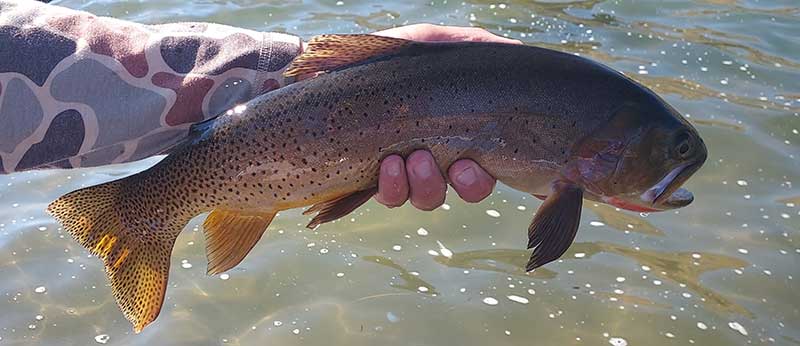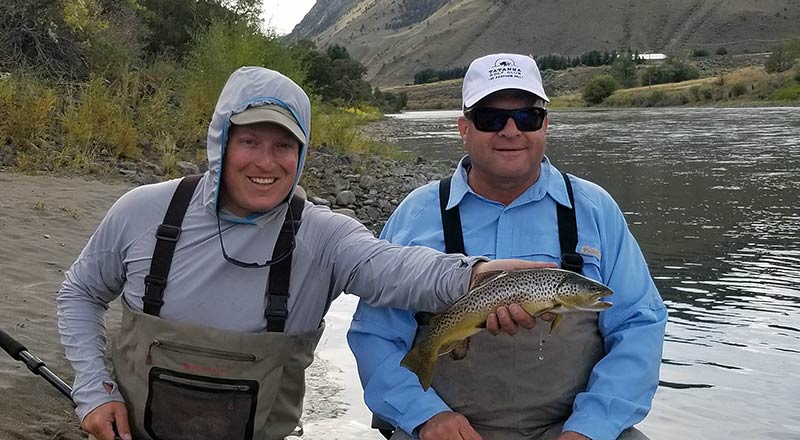Early Fall Float Trips
Posted on January 23rd, 2024 in Uncategorized

Early Fall Float Trips: Introduction
As air and water temperatures cool in late August or the first week of September, flows continue to drop and aquatic insect hatches turn back on. The next month or so, basically the month of September, offers the best match-the-hatch fishing of the season. Even large trout sometimes rise to tiny flies, and good fishing is still possible with terrestrial dry flies as well.
Early fall float trips are all about flexibility. If it’s warm and bright, we’ll want to fish hoppers and ants for numbers of free-rising cutthroats on the upper Yellowstone or for rainbows and browns on the lower Stillwater. If it’s cool and gray, it might be prime time to float the Yellowstone’s “town section” or east of Livingston and hope for a few monsters.

This is rapidly becoming the second most-popular period for float trips in the region, after early summer, and for good reason: the weather and water conditions are great, the fish are fat and healthy, and the crowds of general tourists have departed. There can still be quite a few fishing boats out on the water, but except on Labor Day Weekend there are far fewer than during the summer. The Stillwater River in particular is far less busy once September rolls around than earlier.
Here are a couple facts to keep in mind while you read this post:
- Early autumn is our favorite time to guide float trips on the Yellowstone and Stillwater Rivers (provided the Stillwater is high enough, sometimes it’s too low in the fall).
- While there aren’t any monster trout included on this page, every pictured fish here ate a dry fly. In fact, probably 80% of the trout we see on early fall float trips eat dries. Most of the rest eat emergers or small nymphs beneath these dries.

Early Fall Float Trips: Quick Facts
- Best Waters: The Yellowstone and Stillwater are the best options at this time, but the Lower Madison turns back on, as well.
- Three Top Reasons to Come in Early Autumn: 1.) The widest range of tactics of the season might work at this time, depending on weather and water conditions. 2.) Crowds of general tourists nosedive, and while there can still be quite a few anglers out on big-name rivers like the Yellowstone and Madison, there are far fewer than earlier in the year. Note that popular wade fisheries remain quite crowded through September. 3.) The best “match-the-hatch” fishing of the year typically occurs during this period.
- Three Top Reasons to Avoid Early Autumn: 1.) Fishing and weather/water conditions are less consistent than they are during the summer. 2.) The fish can be spooky. 3.) The fishing tends to “ebb and flow” much more at this time of year than earlier: it’s good for a while, then gets tough, or vice-versa.
- Perfect Clients: Clients who enjoy less-crowded conditions, come prepared for a wide range of weather and water conditions, and are willing to use the tactics the trout demand, whatever they may be. Early fall also offers some of the easiest beginner floating of the year, due to the aggressiveness of the mountain whitefish.
- What Early Autumn Does Best: Early fall offers great (if sometimes inconsistent) match-the-hatch fishing during Blue-winged Olive mayfly emergences. This is our favorite hatch of the year, which is why early fall is our favorite time to guide float trips.
Early Fall Float Trips: The Details
Early fall is just awesome. The fishing isn’t as consistent as it is in early summer, and the big grasshoppers don’t work as well as they do in late summer, but the mayfly hatches, the eagerly-rising trout that are in their best shape of the year, the falling crowds of competing anglers, and the fall colors more than make up for it.
This period runs from the first hints of colder weather in late August or early September when the late summer water temps drop sharply, until the first really cold weather hits sometime in early October. On warm days, this is still wet-wading season. On cool, rainy days, we wear waders and layer up and are very happy to do it.
With cold nights and often hot days, and a good chance of fall rains to freshen the rivers and make the mayflies hatch, the fishing is extremely varied at this time of year, both from day to day and even over the course of a given day. It’s often hard to predict what will happen, even with an accurate weather forecast. This makes early fall the most interesting time of year to fish the region, for good and ill.

Tactics are all over the place in early fall, but we emphasize dry fly fishing on the Yellowstone River and dry-dropper on the Stillwater and Lower Madison. Streamers are a changeup technique for experienced anglers. We seldom resort to strike indicators and deep-nymphing in early fall except when guiding beginners.
First thing in the morning, we might throw streamers before switching to mayfly imitations, then swap the mayflies for grasshoppers during the warmest part of the day. Or the day might start off warm and sunny with hoppers hopping, then get cloudy and cool and prompt an immense afternoon mayfly hatch.
Regardless of the specific fly we tie on a client’s line, the prime mover of early fall fishing is mayfly emergences. Hoppers and ants still draw some action, but mayfly imitations both on the surface and fished as droppers under hoppers are what separate the great days from the decent ones.
There are several mayflies of note: Mahoganies, Tricos, Tan Drakes (sometimes called Drake Mackerals), and especially several species of Blue-winged Olives (BWO or Baetis). If the mayflies are hatching in profusion and the trout are going crazy, the fishing can be epic. If there’s at least a trickle of mayflies, the fishing will be solid. If it’s bright and sunny and the mayflies aren’t popping, it might be tough unless the hoppers are still hopping in profusion.

The epic dry fly days in our guiding year are more likely to happen at this time than at any other. This is also the period during the peak season when fishing is likely to be tough. We like to tell people that floating in July will usually mean a seven or eight out of ten in terms of angling quality. In early fall, it might well be a ten. It might also be a two. Sevens and eights are still more common, but the variability is higher in early autumn, and it’s important to accept that.
Variability is actually less common with beginners in early fall than with experienced anglers. Why? Whitefish. These under-appreciated gamefish are preparing for their spawn and therefore hyper-aggressive. This makes them great beginner options. We typically have beginners fish a nymph and a streamer under an indicator, and they’ll usually fill the boat with “whiteys” and get a few good trout, too. This opportunity makes early fall the best time for beginners to float.
Early fall is a good time for anglers who like to keep “banker’s hours.” Unless our clients want to throw streamers first thing in the morning for chances at one or two big fish, there’s seldom any reason to be on the water before 9:00 or 10:00. The fishing is usually good until around 5:00. We typically run either full-day trips that run a hair short or half-day trips that aim to get on the water around 10:30 or 11:00.
>>>>>>>>>>>>> Return to the Float Trips Page
